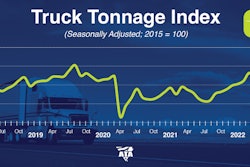Truck freight volume and spending in the second quarter of 2023 declined by the highest levels since the early days of the pandemic, the latest U.S. Bank Freight Payment Index revealed.
Spending by shippers dropped 10.9% compared to the second quarter of 2022 while shipment volume dropped 9%, signs that “trucking is in the midst of a significant slowdown,” according to Bob Costello, senior vice president and chief economist at the American Trucking Associations. "Weaker consumer demand for goods and a slowdown in manufacturing activity and housing starts are having a major impact on the industry – especially carrier operations.”
Shipment levels nationwide have decreased for five consecutive quarters, according to the Index.
Jason Miller, supply chain professor at the Eli Broad College of Business at Michigan State, said the ongoing freight recession in trucking and container shipping, unlike during the global financial crisis, is heavily a function of economic activity such as selling building materials regressing towards a long-term mean, as opposed to a fundamental collapse of demand like in 2008 and 2009.
"This has important implications for recovering from the current trough in demand. My hunch is exiting the trough will be slower coming out of this cycle because we need a shock to get us above the long-term trendline," he added. "This isn’t good news for carriers that are hoping for a robust recovery of demand in 2024."
Seasonally and inflation adjusted retail sales for building material retails March through June 2023, Miller said, have seen inflation adjusted demand about 10% off the 2021 peak. This said, June 2023 had demand that was 8% above June 2019. "As such, we are still above pre-COVID demand levels, but we have fallen quite sharply from the peak period," he added.
That these two sectors have experienced bloated inventories over the past 18 months, Miller said it is reasonable to expect caution regarding imports over the coming months, especially for general merchandisers who have a disproportionate amount of their sales in the last three months of the year.
March through June 2023 has seen general merchandise retail sales dip 4% from this peak period, and almost 10% from those highest months. However, demand in June 2023 was 9% higher than June 2019, suggesting a regression to the mean scenario, Miller theorized.
In the second quarter, volume dropped most in the Northeast (27.1%) and Southeast (12.6%) year-over-year. The Southwest continued to be a bright spot, with shipments increasing 14.8%.
Truck freight spending levels have now contracted year-over-year for two consecutive quarters. With spending at all-time high levels for the preceding six quarters, the recent drops brought spend activity back to its relatively strong levels of mid-2021.
The Midwest region had the sharpest spending drop in the second quarter, 18.7% year-over-year. The Northeast and West also experienced double-digit spending declines, dropping 10.9% and 10.2%, respectively versus the second quarter of 2022.
“In the spot market, we’ve been observing for a while sharp spending drops caused by lower volumes and increased capacity," said Bobby Holland, director of freight business analytics, U.S. Bank. "This trend has now solidly penetrated the contract freight market. Nearly every category we track – both nationwide and regionally – contracted in second quarter."
Will Post, enterprise account executive with DAT, noted that dry van spot rates went down slightly at the end of July on higher volume and that active contract rates decreased, showing signs of slowing and flattening. Contract replacement rates turned to single digits after a long period of double digits, he added.
Regional data, according to U.S. Bank Freight Payment Index
West
Shipments
Linked quarter: -2.6%
Year over year: -15.7%
Spending
Linked quarter: -9.0%
Year over year: -10.2%
Truck freight continued to struggle in the West region as port activity and housing starts there continued to slow. This is the lowest point for shipments in the West in three years.
Southwest
Shipments
Linked quarter: 2.9%
Year over year: 14.8%
Spending
Linked quarter: -6.4%
Year over year: 4.3%
Continuing to outperform other regions, Southwest volume is benefiting from increased truck-transported trade with Mexico. The 14.8% year-over-year increase in shipments is the highest since 2018.
Midwest
Shipments
Linked quarter: -0.5%
Year over year: -9.0%
Spending
Linked quarter: -9.4%
Year over year: -18.7%
Continued slowdowns in manufacturing likely led to year-over-year shipments dropping by the largest level in the region since Q4 2021. Yearly spending also dropped by the largest amount since Q2 2020.
Northeast
Shipments
Linked quarter: -9.2%
Year over year: -27.1%
Spending
Linked quarter: -10.9%
Year over year: -11.0%
The 27.1% volume contraction is the largest in the history of the Freight Payment Index. The region faces multiple headwinds, including low housing starts. However, the contraction in household consumption likely had the biggest impact for this populated area.
Southeast
Shipments
Linked quarter: -0.2%
Year over year: -12.6%
Spending
Linked quarter: -6.7%
Year over year: -2.5%
Even though shipments contracted 12.6% year over year and slightly on a linked quarter basis, this was an improvement for the region. In the first quarter, shipments fell 16.1% year over year and 10.1% on a linked quarter basis.










